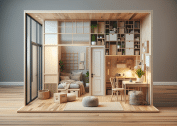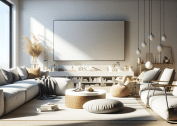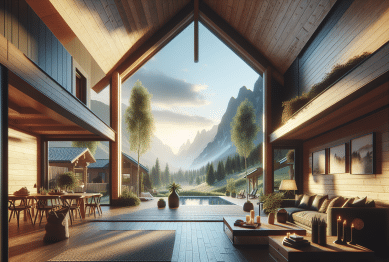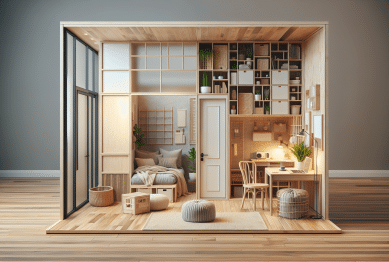Discover the world of minimalist home decor and how it can transform any living space into an inviting, serene retreat. This guide uncovers practical ideas, space-saving trends, and design strategies that help create a harmonious environment while focusing on comfort and personality.
Understanding the Heart of Minimalist Home Decor
Minimalist home decor is more than a visual style. It is a philosophy rooted in simplicity, clarity, and intentionality. The aim is to create spaces that evoke calmness and showcase only what matters most to the resident. This style isn’t about stripping away comfort but nurturing an environment free from clutter and filled with functional beauty. Every object has its place. Each piece is selected for purpose and harmony. When designed with care, minimalist spaces invite a sense of relaxation that lingers long after the first impression.
Subtle color palettes play a significant role in minimalism. Picture soft whites, muted grays, and calming earth tones. These colors encourage light to bounce gently through each room, creating an open, airy feel even in smaller environments. But it isn’t just the colors. Clean lines and quality materials elevate minimalist interiors, with natural wood, smooth ceramics, and linen textiles often at the fore. These details might be understated, but they’re never dull—each one adds a unique layer to the overall atmosphere.
Some may wonder if minimalist decor risks being too cold or sparse. However, the true spirit of the style lies in its flexibility. Personal touches are carefully woven into the environment, whether it’s a single art print, a cherished sculpture, or a family heirloom. The idea is to highlight what you love most—without overwhelming your senses. As households explore this approach, many find that minimalist decor becomes a path toward greater mindfulness and appreciation for their own surroundings. (Source: https://www.architecturaldigest.com/story/minimalist-home-decor-guide)
Decluttering for a Calmer Space: Where to Begin
Embracing minimalist home decor often starts with decluttering. This isn’t a one-time purge but a gradual, thoughtful process. Begin with one room or category at a time. Remove items that lack daily function or sentimental value. For many, tackling the entryway or living room first provides a sense of immediate accomplishment and motivates further progress. A practical tip: dedicate a basket for items to donate or recycle, simplifying the decision-making process each day.
Organization is the backbone of a minimalist home. Storage solutions that hide away everyday objects—like lidded boxes, floating shelves, or built-in cabinetry—preserve visual clarity. Multifunctional furniture plays an important role here, doubling as both utility and design. Consider ottomans with hidden compartments or side tables that nest for easy rearrangement. When surfaces are left clear, the entire room feels lighter and more welcoming. The positive psychological effects of decluttering have even been studied, resulting in improved mood and reduced stress for inhabitants. (Source: https://www.apa.org/topics/healthy-homes/de-cluttering)
Maintenance is easier with fewer things to manage. The minimalist lifestyle is not about living with the bare minimum but about purposefully curating possessions. Seasonal reviews of your belongings keep your environment refreshed and aligned with your current needs. Over time, many find it easier to keep things tidy—most surfaces and storage spaces remain organized, with time saved in cleaning and upkeep. Small changes, such as placing a decorative tray on the coffee table for essentials, can keep minimalist spaces functional while remaining visually appealing.
Choosing the Right Minimalist Furniture and Textiles
Minimalist home decor places quality above quantity. When selecting furniture, the emphasis should be on well-crafted pieces that offer comfort without unnecessary embellishment. Sofas with smooth lines, dining tables in light woods, and beds with unobtrusive frames are popular choices. Instead of multiple accent chairs or crowded bookcases, opt for a few standout items that draw the eye. Minimalist furniture often showcases innovative use of materials—think recycled wood, powder-coated metals, or sustainable fabrics. These elements not only align with the style’s values but also support a more eco-conscious approach to decorating. (Source: https://www.houzz.com/magazine/minimalist-style-furnishings-stsetivw-vs~267#)
Textiles have the power to soften minimalist aesthetics. Neutral-colored curtains gently diffuse sunlight while maintaining privacy. Rugs in subtle hues add warmth underfoot without overwhelming the space. Even throw blankets or pillows can find their place in a minimalist home, provided their colors and textures complement the existing palette. The secret is restraint: instead of layering multiple patterns and shades, choose one or two harmonious elements that enhance the core design. For bedding, crisp white sheets with a single accent pillow can evoke hotel-like tranquility.
Attention to materials is essential in minimalist interiors. Natural fibers like linen, cotton, and jute create a tactile experience that adds depth to the décor. These choices are timeless—unlike trend-driven synthetics, they rarely go out of style. When it comes to window treatments or area rugs, opt for lightweight options that allow the room’s architecture to shine. Incorporating sustainable pieces also speaks to the minimalist commitment to mindful consumption, ensuring your home reflects both personal values and enduring comfort. (Source: https://www.thespruce.com/minimalist-decorating-ideas-4120147)
Mastering Space: Layout, Lighting, and Flow
Minimalist decor thrives on effective use of space. room layouts should encourage easy movement and interaction, with clear pathways that feel open, not obstructed. Floating shelves and wall-mounted lighting free up valuable floor real estate, making even compact rooms feel expansive. Consider arranging furniture in a way that maximizes both functionality and visual appeal. In the kitchen, for example, streamlined cabinetry and countertop appliances keep everything neatly stored and within reach.
Lighting is crucial in crafting a minimalist ambiance. Natural light is always favored—large windows, sheer drapes, and strategically placed mirrors help reflect daylight deep into the interior. For artificial lighting, look for simple pendant fixtures or sleek LED bars. Dimmable switches allow for control over mood and energy efficiency. Subtle, indirect lighting can accentuate architectural features without creating harsh contrasts. This creates an inviting and balanced atmosphere that’s easy on the eyes by day or night. (Source: https://www.yaleappliance.com/blog/minimalist-lighting-design)
Visual flow matters. Keep sight lines open. Place larger pieces against walls, anchoring them with smaller accents. Neutral or matching tones on adjacent surfaces support harmony from room to room. Add a statement light fixture or an architectural sculpture as a focal point. Plants, especially in simple terracotta or ceramic pots, introduce gentle vibrancy without disrupting simplicity. Each decision reinforces the sense of order that defines minimalist homes. These subtle design choices can make any living space appear larger, brighter, and more cohesive with minimal effort.
Personalizing a Minimalist Interior Without Clutter
Adding personality to a minimalist home does not mean reintroducing clutter. The secret is mindful selection. Choose artwork with clean lines or soft abstracts for the walls, displayed on their own or in a small, coordinated grouping. Photographs in matching frames and monochrome palettes can tell a story without demanding attention. Sculptural vases or handmade ceramics add subtle interest on dining tables and shelves. In minimalist home decor, fewer items create deeper impact and visual calm.
Color can be used wisely. Minimalist interiors often center around neutral palettes, but a single vibrant color may highlight a favorite area or object. Consider a blue accent wall behind a reading nook or a green plant centerpiece on a dining table. These small gestures infuse warmth and character without overwhelming the senses. Books, displayed with intention, can also personalize a space—choose covers and topics that speak to your interests, limiting the display to a carefully edited stack or shelf.
Personal minimalism supports lifestyle flexibility. It is possible to update a room’s look by rearranging existing objects rather than buying more. As needs change, the design can evolve organically. Many discover that their favorite memories and stories stand out more when surrounded by open space, rather than hidden within busy collections. Personalized minimalism means celebrating what matters most to you, in a way that brings peace and joy whenever you step through the door. (Source: https://www.housebeautiful.com/room-decorating/tips/a2081/minimalist-design-ideas)
Minimalist Trends and Sustainable Design Choices
Minimalist home decor continues to evolve, with sustainability at its core. The most popular trends now prioritize eco-friendly materials and responsible manufacturing. Reclaimed wood, recycled metals, and organic textiles are increasingly favored over synthetics. Choosing furniture from companies that use sustainable harvesting or local artisans not only supports the environment but gives your rooms a unique flair. People are also moving away from disposable décor, investing in quality pieces intended to last for many years.
Technology and minimalism are merging, too. Smart home features, like adjustable lighting and automated climate controls, complement the aesthetic by eliminating visual clutter. Wall panels that hide cables, wireless speakers, and compact gadgets align with minimalist values and provide convenience. As the world becomes more connected, minimalist interiors make it easy to strike a balance between form and function, supporting both relaxation and productivity in every corner.
Sustainability also means purchasing less and reusing more. Upcycling vintage finds or repurposing existing furniture reduces waste and contributes to a personal, storied design. With increased awareness of environmental impact, many now seek ways to combine minimalist principles with eco-conscious choices. This approach can inspire creative solutions—transforming old doors into tables or using reclaimed shelves—to produce beautiful, personalized spaces that are kinder to the earth. (Source: https://www.archdaily.com/927335/the-evolution-of-the-minimalist-interior)
References
1. Architectural Digest. (n.d.). Minimalist Home Decor Guide. Retrieved from https://www.architecturaldigest.com/story/minimalist-home-decor-guide
2. American Psychological Association. (n.d.). The Benefits of De-Cluttering. Retrieved from https://www.apa.org/topics/healthy-homes/de-cluttering
3. Houzz. (n.d.). Minimalist Style Furnishings. Retrieved from https://www.houzz.com/magazine/minimalist-style-furnishings-stsetivw-vs~267#
4. The Spruce. (n.d.). Minimalist Decorating Ideas. Retrieved from https://www.thespruce.com/minimalist-decorating-ideas-4120147
5. Yale Appliance. (n.d.). Minimalist Lighting Design Tips. Retrieved from https://www.yaleappliance.com/blog/minimalist-lighting-design
6. ArchDaily. (n.d.). The Evolution of the Minimalist Interior. Retrieved from https://www.archdaily.com/927335/the-evolution-of-the-minimalist-interior









